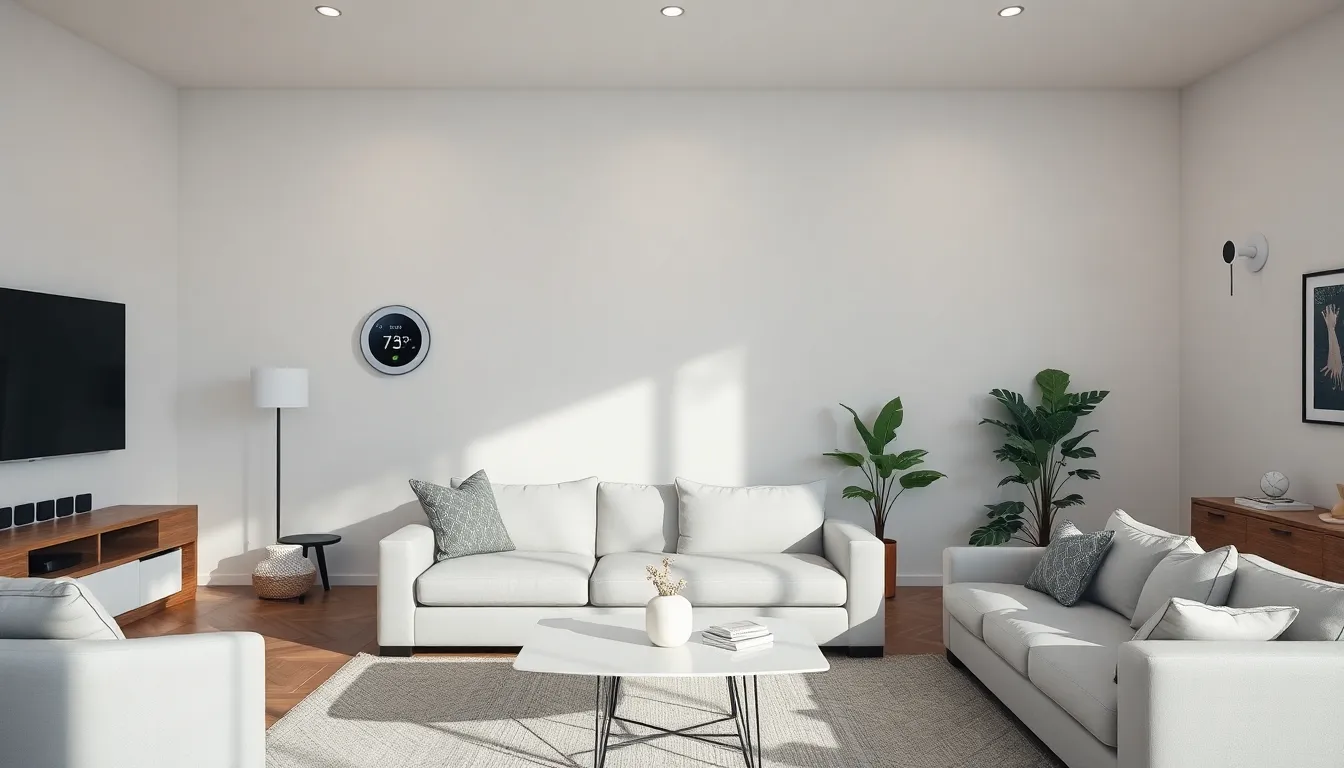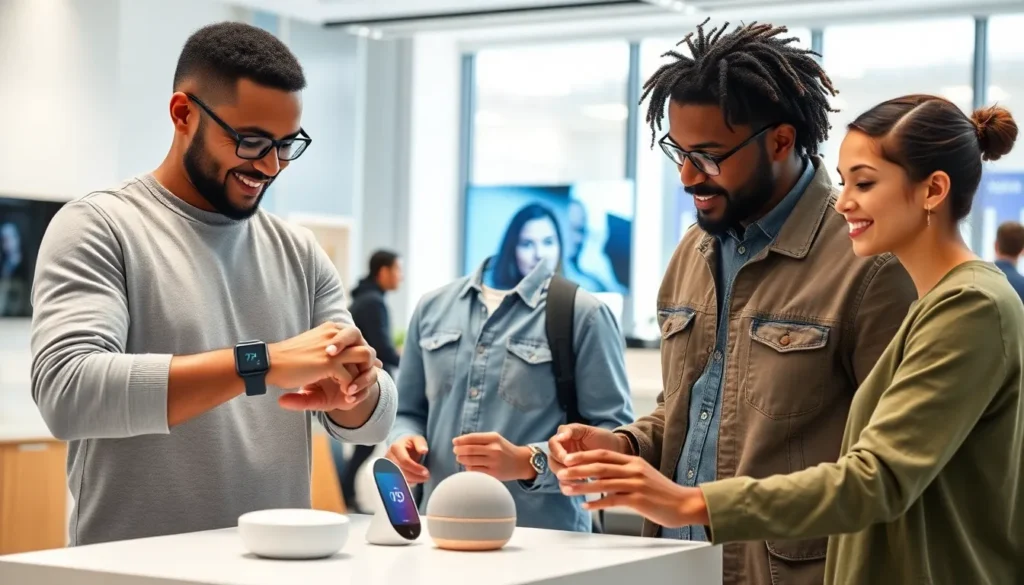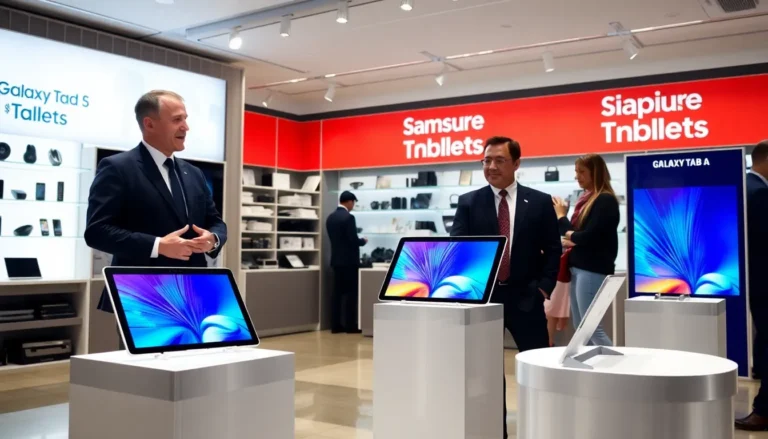In today’s fast-paced world, the gadget market is evolving at lightning speed. From smartphones to smart home devices, technology continuously reshapes how people interact with their environment. As consumers become more tech-savvy, understanding the latest trends in this dynamic landscape is crucial for businesses and enthusiasts alike.
Emerging technologies like artificial intelligence and the Internet of Things are driving innovation, creating new opportunities and challenges. Keeping a finger on the pulse of these trends not only helps in making informed purchasing decisions but also highlights the direction the market is heading. Whether it’s the rise of wearable tech or the increasing demand for sustainable gadgets, staying updated is key to navigating this exciting realm.
Table of Contents
ToggleOverview of Gadget Market Trends
The gadget market is evolving rapidly, influenced by advancements in technology and changing consumer behaviors. Key trends include the rise of artificial intelligence (AI) and the Internet of Things (IoT), which are redefining how devices integrate into daily life.
Growth of Wearable Technology
Wearable technology continues to gain traction, with a market size expected to reach $60 billion by 2023. Devices such as smartwatches and health trackers enhance personal health monitoring and fitness engagement. Companies focus on innovative designs and features that appeal to health-conscious consumers.
Increase in Sustainable Gadgets
Sustainability drives the gadget market toward eco-friendly products. Brands promote gadgets made from recyclable materials and energy-efficient designs. This shift not only attracts environmentally aware consumers but also aligns with global sustainability goals.
Integration of Smart Home Devices
Smart home technology is on the rise, with market projections reaching $174 billion by 2025. Smart speakers, lighting, and security systems enhance home automation. Consumers prioritize convenience and security, propelling the demand for interconnected devices.
Advancements in Mobile Technology
Mobile technology shows continuous improvement, particularly with 5G connectivity. Faster networks enhance user experiences in gaming, streaming, and communication. The demand for high-performance smartphones remains strong, with brands incorporating advanced features like foldable screens and improved cameras.
Growth of Augmented and Virtual Reality
Augmented reality (AR) and virtual reality (VR) technologies are gaining momentum in the gadget market. These technologies find applications in gaming, education, and training. As hardware becomes more affordable, user engagement with AR and VR experiences increases.
The gadget market’s trends illustrate a landscape shaped by innovation, sustainability, and consumer demands. Staying informed on these trends provides insights that benefit both consumers and businesses in navigating the ever-changing market.
Current Trends in Gadget Development

Gadget development is evolving rapidly, focusing on enhancing user experience and sustainability. Key trends include advancements in wearable technology and the surging popularity of smart home devices.
Wearable Technology Advancements
Wearable technology continues to expand its influence in various sectors, with a projected market size of $60 billion by 2023. Health-focused wearables, such as smartwatches and fitness trackers, dominate this space. Features like heart rate monitoring, sleep tracking, and fitness coaching drive user engagement. Companies like Apple and Fitbit lead the market by introducing innovative sensors and advanced health metrics. Furthermore, integration with mobile applications enhances the functionality of these devices, allowing users to monitor health data in real-time.
Smart Home Devices Popularity
Smart home devices are increasingly popular, with market projections indicating a value of $174 billion by 2025. Consumers favor smart thermostats, security systems, and voice-activated assistants for their convenience and energy efficiency. The rise of connectivity standards like Matter promotes interoperability among devices, ensuring seamless experiences for users. Market leaders such as Amazon and Google continuously innovate, developing new features to enhance security, energy management, and user convenience. The expansion of smart devices within homes reflects broader consumer demands for automation and integrated technology solutions.
Consumer Preferences in Gadget Purchasing
Consumer preferences in the gadget market are significantly influenced by various factors, including environmental concerns and pricing strategies.
Eco-Friendly Gadgets
Eco-friendly gadgets attract consumers looking for sustainable options. Brands are increasingly prioritizing recyclable materials and energy-efficient designs. The global market for sustainable gadgets reached approximately $10 billion in 2022, reflecting a growing concern for environmental impact. Consumers prefer products that not only perform well but also contribute to reducing carbon footprints. For instance, solar-powered chargers and biodegradable phone cases are now popular choices. This trend showcases a shift toward sustainability in consumer electronics.
Price Sensitivity Among Consumers
Price sensitivity plays a crucial role in gadget purchasing decisions. A 2022 survey indicated that 65% of consumers prioritize price over brand loyalty when choosing gadgets. About 70% of consumers consider discounts and promotions essential when making purchases. Mid-range gadgets maintain appeal, providing a balance of quality and affordability. As competition increases, brands are incorporating flexible pricing strategies, like subscription models, to cater to diverse consumer budgets. This adaptability ensures larger market reach and enhances consumer satisfaction.
Impact of Emerging Technologies
Emerging technologies significantly influence the gadget market, shaping consumer experiences and driving innovation. Technologies such as artificial intelligence (AI) and 5G are leading this transformation, offering enhanced functionality and connectivity.
Artificial Intelligence in Gadgets
Artificial intelligence reshapes gadget capabilities, enabling smart features that enhance user interaction. AI-driven devices, including smart speakers and virtual assistants, facilitate seamless voice recognition and personalized responses. Machine learning algorithms improve performance through data analytics, allowing gadgets to adapt to user preferences and behaviors. For example, fitness trackers analyze users’ health data, offering tailored insights that promote healthier lifestyles. The integration of AI in gadgets fosters innovation, driving demand and enhancing user engagement.
5G Technology and Its Implications
5G technology revolutionizes connectivity in the gadget market. This advanced network offers higher speeds, lower latency, and greater capacity, enabling a surge in connected devices. Smart home products benefit from 5G’s reliability, allowing instantaneous communication between devices—smart cameras and security systems exemplify this trend. Furthermore, 5G supports augmented reality (AR) and virtual reality (VR) experiences, enhancing applications in gaming and immersive training. As businesses and consumers adopt 5G-enabled gadgets, market growth accelerates, reshaping how users interact with technology.
Future Predictions for the Gadget Market
Gadget market predictions highlight the anticipated advancements in technology shaping consumer preferences and industry direction.
- AI Integration
AI technology is expected to enhance user experiences. Devices featuring voice recognition, gesture control, and personalized settings will become more widespread, enabling smarter interactions and improved functionality.
- 5G Adoption
5G connectivity will revolutionize device communication, facilitating seamless integration of smart home systems and wearable technology. The rapid transfer of data will enhance functionalities such as real-time health monitoring and smart home automation.
A marked shift towards sustainability will dominate innovation. By 2025, the sustainable gadget market may exceed $20 billion, fueled by consumer demand for eco-friendly products. Brands that prioritize recyclable materials and energy-efficient designs will gain a competitive edge.
- Health and Fitness Gadgets
The wearable technology sector will likely surpass $100 billion by 2025, driven by health-focused devices. Smartwatches and fitness trackers featuring advanced sensors will increasingly monitor health metrics, appealing to health-conscious consumers.
- Home Automation Systems
Smart home technology is predicted to expand significantly. Market projections indicate a surge to $200 billion by 2026, as interconnected devices improve home security and energy management. Enhanced interoperability will drive consumer adoption of these systems.
- Personalized Devices
Customization in gadgets will gain importance. As consumers prefer products tailored to their preferences, brands will leverage AI and data analytics to offer personalized solutions that meet individual needs and suit lifestyles.
- Subscription Services
Flexible pricing models, such as subscription services, are set to rise. Consumers will opt for affordable installments over large upfront investments, prompting brands to explore diverse pricing strategies accommodating various budgets.
- Augmented Reality Applications
Augmented reality (AR) technology will see increased implementation in consumer gadgets. By integrating AR into gaming, training, and shopping experiences, brands will provide immersive interactions that captivate users and enhance engagement.
Gadget market predictions illustrate a landscape full of possibilities, driven by technological advancements, consumer preferences, and sustainability efforts, positioning businesses for growth in this evolving sector.
The gadget market is on the brink of remarkable transformation. As technology continues to evolve at a rapid pace consumers and businesses alike must adapt to the shifting landscape. The rise of wearable technology and smart home devices showcases a growing demand for convenience and health-focused solutions.
Sustainability is becoming a pivotal factor in purchasing decisions with eco-friendly gadgets gaining traction among consumers. This trend highlights a collective shift towards responsible consumption.
Looking ahead the integration of AI and 5G will redefine user experiences and connectivity. With these advancements the future of the gadget market promises innovation that aligns with consumer needs and environmental consciousness. Staying informed about these trends will be essential for anyone looking to thrive in this dynamic market.








